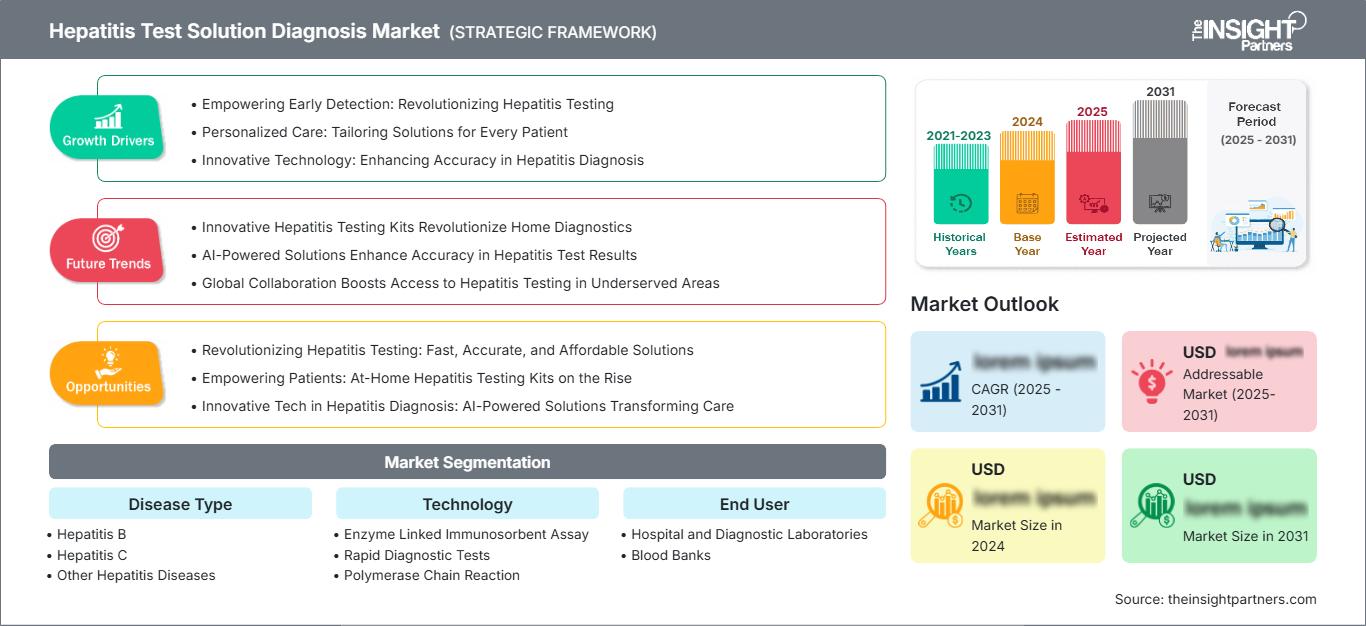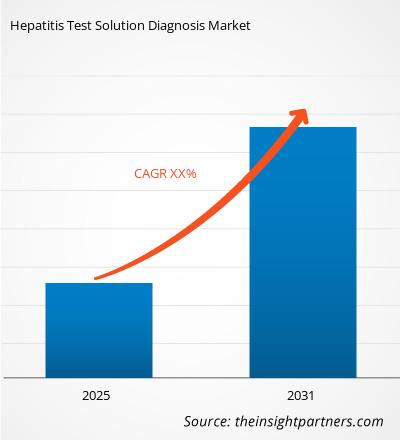Si prevede che il mercato delle soluzioni diagnostiche per i test dell'epatite registrerà un CAGR del XX% dal 2025 al 2031, con una dimensione del mercato in espansione da XX milioni di dollari nel 2024 a XX milioni di dollari entro il 2031.
Il rapporto è suddiviso in base al tipo di malattia (epatite B, epatite C, altre epatiti) e analizza ulteriormente il mercato in base alla tecnologia (test immunoenzimatico, test diagnostici rapidi, reazione a catena della polimerasi, tecnologia di amplificazione isotermica degli acidi nucleici, altre tecnologie). Esamina inoltre il mercato per utente finale (ospedali e laboratori diagnostici, banche del sangue). Viene fornita una ripartizione completa a livello globale, regionale e nazionale per ciascuno di questi segmenti chiave. Il rapporto include le dimensioni del mercato e le previsioni per tutti i segmenti, presentando i valori in dollari statunitensi. Fornisce inoltre statistiche chiave sullo stato attuale del mercato dei principali attori, insieme ad approfondimenti sulle tendenze prevalenti e sulle opportunità emergenti.
Scopo del rapporto
Il rapporto "Hepatitis Test Solution Diagnosis Market" di The Insight Partners mira a descrivere il panorama attuale e la crescita futura, i principali fattori trainanti, le sfide e le opportunità. Ciò fornirà spunti a vari stakeholder aziendali, come:
- Fornitori/Produttori di tecnologia: per comprendere le dinamiche di mercato in evoluzione e conoscere le potenziali opportunità di crescita, consentendo loro di prendere decisioni strategiche informate.
- Investitori: per condurre un'analisi completa delle tendenze in merito al tasso di crescita del mercato, alle proiezioni finanziarie di mercato e alle opportunità esistenti lungo la catena del valore.
- Enti di regolamentazione: per regolamentare le politiche e le attività di controllo sul mercato con l'obiettivo di ridurre al minimo gli abusi, preservare la fiducia degli investitori e sostenere l'integrità e la stabilità del mercato.
Segmentazione del mercato della diagnosi delle soluzioni per i test dell'epatite Tipo di malattia
- Epatite B
- Epatite C
- Altre malattie epatitiche
Tecnologia
- Saggio immunoenzimatico
- Test diagnostici rapidi
- Reazione a catena della polimerasi
- Tecnologia di amplificazione isotermica degli acidi nucleici
- Altre tecnologie
Utente finale
- Laboratori ospedalieri e diagnostici
- Banche del sangue
Potrai personalizzare gratuitamente qualsiasi rapporto, comprese parti di questo rapporto, o analisi a livello di paese, pacchetto dati Excel, oltre a usufruire di grandi offerte e sconti per start-up e università
Mercato delle soluzioni per la diagnosi dei test dell'epatite: Approfondimenti strategici

-
Ottieni le principali tendenze chiave del mercato di questo rapporto.Questo campione GRATUITO includerà l'analisi dei dati, che vanno dalle tendenze di mercato alle stime e alle previsioni.
Fattori di crescita del mercato della diagnosi delle soluzioni per i test dell'epatite
- Potenziare la diagnosi precoce: rivoluzionare i test dell'epatite
- Assistenza personalizzata: soluzioni su misura per ogni paziente
- Tecnologia innovativa: migliorare l'accuratezza nella diagnosi dell'epatite
Tendenze future del mercato della diagnosi delle soluzioni per i test dell'epatite
- Kit innovativi per i test dell'epatite rivoluzionano la diagnostica domiciliare
- Le soluzioni basate sull'intelligenza artificiale migliorano l'accuratezza nei risultati dei test dell'epatite
- La collaborazione globale aumenta l'accesso ai test dell'epatite nelle aree meno servite
Opportunità di mercato per la diagnosi delle soluzioni per i test dell'epatite
- Rivoluzionare i test dell'epatite: soluzioni rapide, accurate e convenienti
- Dare potere ai pazienti: kit per il test dell'epatite a domicilio in aumento
- Tecnologia innovativa nella diagnosi dell'epatite: soluzioni basate sull'intelligenza artificiale che trasformano l'assistenza sanitaria
Mercato delle soluzioni per la diagnosi dei test dell'epatite
Le tendenze regionali e i fattori che influenzano il mercato delle soluzioni diagnostiche per i test dell'epatite durante il periodo di previsione sono stati ampiamente spiegati dagli analisti di The Insight Partners. Questa sezione illustra anche i segmenti e la distribuzione geografica del mercato delle soluzioni diagnostiche per i test dell'epatite in Nord America, Europa, Asia-Pacifico, Medio Oriente e Africa, America meridionale e centrale.
Ambito del rapporto di mercato sulla diagnosi delle soluzioni per il test dell'epatite
| Attributo del rapporto | Dettagli |
|---|---|
| Dimensioni del mercato in 2024 | US$ XX Million |
| Dimensioni del mercato per 2031 | US$ XX Million |
| CAGR globale (2025 - 2031) | XX% |
| Dati storici | 2021-2023 |
| Periodo di previsione | 2025-2031 |
| Segmenti coperti |
By Tipo di malattia
|
| Regioni e paesi coperti |
Nord America
|
| Leader di mercato e profili aziendali chiave |
|
Densità degli operatori del mercato della diagnosi delle soluzioni per i test dell'epatite: comprendere il suo impatto sulle dinamiche aziendali
Il mercato delle soluzioni diagnostiche per i test dell'epatite è in rapida crescita, trainato dalla crescente domanda degli utenti finali, dovuta a fattori quali l'evoluzione delle preferenze dei consumatori, i progressi tecnologici e una maggiore consapevolezza dei benefici del prodotto. Con l'aumento della domanda, le aziende stanno ampliando la propria offerta, innovando per soddisfare le esigenze dei consumatori e sfruttando le tendenze emergenti, alimentando ulteriormente la crescita del mercato.

- Ottieni il Mercato delle soluzioni per la diagnosi dei test dell'epatite Panoramica dei principali attori chiave
Punti di forza
- Copertura completa: il rapporto copre in modo completo l'analisi di prodotti, servizi, tipologie e utenti finali del mercato delle soluzioni diagnostiche per i test dell'epatite, fornendo un panorama olistico.
- Analisi degli esperti: il rapporto è compilato sulla base della conoscenza approfondita di esperti e analisti del settore.
- Informazioni aggiornate: il rapporto garantisce rilevanza aziendale grazie alla sua copertura di informazioni recenti e tendenze dei dati.
- Opzioni di personalizzazione: questo rapporto può essere personalizzato per soddisfare le esigenze specifiche del cliente e adattarsi in modo appropriato alle strategie aziendali.
Il rapporto di ricerca sul mercato delle soluzioni diagnostiche per i test dell'epatite può, quindi, aiutare a guidare il percorso di decodificazione e comprensione dello scenario del settore e delle prospettive di crescita. Sebbene possano esserci alcune preoccupazioni valide, i vantaggi complessivi di questo rapporto tendono a superare gli svantaggi.
- Analisi storica (2 anni), anno base, previsione (7 anni) con CAGR
- Analisi PEST e SWOT
- Valore/volume delle dimensioni del mercato - Globale, Regionale, Nazionale
- Industria e panorama competitivo
- Set di dati Excel
Report recenti
Testimonianze
Motivo dell'acquisto
- Processo decisionale informato
- Comprensione delle dinamiche di mercato
- Analisi competitiva
- Analisi dei clienti
- Previsioni di mercato
- Mitigazione del rischio
- Pianificazione strategica
- Giustificazione degli investimenti
- Identificazione dei mercati emergenti
- Miglioramento delle strategie di marketing
- Aumento dell'efficienza operativa
- Allineamento alle tendenze normative






















 Ottieni un campione gratuito per - Mercato delle soluzioni per la diagnosi dei test dell'epatite
Ottieni un campione gratuito per - Mercato delle soluzioni per la diagnosi dei test dell'epatite